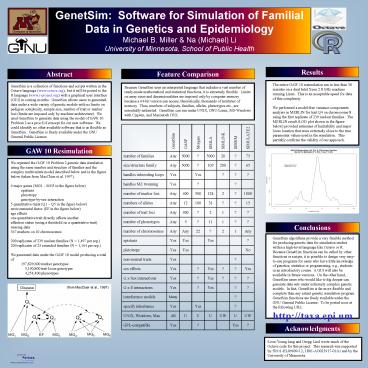48x48 poster template - PowerPoint PPT Presentation
1 / 1
Title:
48x48 poster template
Description:
GenetSim is a collection of functions and scripts written in the Octave language ... GenetSim can run under UNIX, GNU/Linux, MS-Windows with Cygwin, and Macintosh OSX. ... – PowerPoint PPT presentation
Number of Views:36
Avg rating:3.0/5.0
Title: 48x48 poster template
1
GenetSim Software for Simulation of Familial
Data in Genetics and Epidemiology Michael B.
Miller Na (Michael) Li University of Minnesota,
School of Public Health
Results
Abstract
Feature Comparison
The entire GAW 10 resimulation ran in less than
30 minutes on a dual Intel Xeon 2.8 GHz machine
running Linux. This is an acceptable speed for
data of this complexity. We performed a
model-free variance-components analysis in MERLIN
for trait Q4 on chromosome 8 using the first
replicate of 239 nuclear families. The MERLIN
result (LOD plot shown in the figure below)
provided estimates of heritability and major
locus location that were extremely close to the
true parameater values used in the simulation.
This partially confirms the validity of our
approach.
GenetSim is a collection of functions and scripts
written in the Octave language (www.octave.org),
but it will be ported to the R language
(www.r-project.org) with a graphical user
interface (GUI) in coming months. GenetSim
allows users to generated data under a wide
variety of genetic models with no limits on
pedigree complexity, sample size, number of trait
or marker loci (limits are imposed only by
machine architecture). We used GenetSim to
generate data using the model of GAW 10 Problem 2
as a proof of concept for our new software. We
could identify no other available software that
is as flexible as GenetSim. GenetSim is freely
available under the GNU General Public License.
Because GenetSim uses an interpreted language
that includes a vast number of ready-made
mathematical and statistical functions, it is
extremely flexible. Limits on array sizes and
dimensionalities are imposed only by computer
memory because a 64-bit version can access,
theoretically, thousands of terabytes of memory.
Thus, numbers of subjects, families, alleles,
phenotypes etc., are essentially unlimited.
GenetSim can run under UNIX, GNU/Linux,
MS-Windows with Cygwin, and Macintosh OSX.
GAW 10 Resimulation
We repeated the GAW 10 Problem 2 genetic data
simulation using the same number and structure of
families and the complex multivariate model
described below and in the figure below (taken
from MacCluer et al. 1997). 6 major genes (MG1
MG5 in the figure below) epistasis pleiotropy g
enotype-by-sex interaction 5 quantitative traits
(Q1 Q5 in the figure below) environmental
factor (EF in the figure below) age effects one
quantitative trait directly affects
another affection status (using a threshold on a
quantitative trait) missing data 367 markers on
10 chromosomes 200 replicates of 239 nuclear
families (N 1,497 per rep.) 200 replicates of
23 extended families (N 1,164 per rep.) We
generated data under the GAW 10 model producing a
total of 197,829,600 marker genotypes
3,190,800 trait locus genotypes 4,254,400
phenotypes
Conclusions
GenetSim algorithms provide a very flexible
method for producing genetic data for simulation
studies within a high-level language like Octave
or R. Because GenetSim functions can be called
by other functions or scripts, it is possible to
design very easy-to-use programs for users who
have little knowledge of genetics, statistics or
programming, e.g., students in an introductory
course. A GUI will also be available in future
versions. On the other hand, GenetSim users who
would like to dig deeper can generate data sets
under extremely complex genetic models. In fact,
GenetSim is far more flexible and complete than
any extant genetic simulation program. GenetSim
functions are freely available under the GNU
General Public License. To be posted soon at the
following URL http//taxa.epi.umn.edu/GenetSim/
Acknowledgments
Soon-Young Jang and Gregg Lind wrote much of the
Octave code for this project. This research was
supported by 5RO1-HL09609-12, 1R01-AG021917-01A1
and by the University of Minnesota.






























